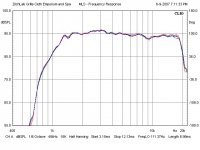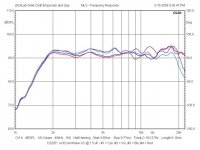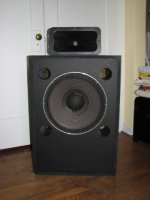OK, the Parts Express part number is 264-270 for the Selenium D220 ti. The JBL teephone number is 818-894-8850. The wave guide part number is 338800-001, price, $9.90 each.
The thread also has the parts express numbers for the crossover components as well.
Russellc
The thread also has the parts express numbers for the crossover components as well.
Russellc
gedlee said:
That I am skeptical about. I've never seen that in my lifetime. Waveguides and Horns are just never that flat.
See post #69.......pretty flat I'd say.
russellc

Russellc said:
See post #69.......pretty flat I'd say.
russellc
I can't view anything on that site.
Are there free field polars or just some living room measurements of the sound field?
Here are four BMS 4555 drivers on JBL PT-F95HF waveguides, on axis, EQ'd using Altec Model 19 crossover:gedlee said:
That I am skeptical about. I've never seen that in my lifetime. Waveguides and Horns are just never that flat.
Attachments
ZilchLab said:Here are four BMS 4555 drivers on JBL PT-F95HF waveguides, on axis, EQ'd using Altec Model 19 crossover:
Thats a 50 dB spread on the plot. That makes the axial response about typical for an EQ'd unit say +- 2 dB.
But what about off-axis? Its easy to EQ a poor waveguide on axis, but that will usually screw up the off-axis response. A good waveguide has to have off axis control so that it can be EQ'd without serious off axis problems. Axial response curves are just not very useful in determining a speakers performance.
Re: EconWave
Again, about what I would expect for an EQ'd unit, maybe a little worse that typical. Why so much variance in the response from driver to driver? Thats way more than I typically see.
ZilchLab said:You need to sign up at AK to see the images, Earl.
And here's four Selenium D220ti drivers on the $9.90 version of that JBL waveguide, again, on axis, EQ'd using the filter documented in the thread:
Again, about what I would expect for an EQ'd unit, maybe a little worse that typical. Why so much variance in the response from driver to driver? Thats way more than I typically see.
Yes, consistent with your acceptance criterion, in fact.gedlee said:
Thats a 50 dB spread on the plot. That makes the axial response about typical for an EQ'd unit say +- 2 dB.
I can EQ within +/- 0.5 dB, typically, but that's somewhat of an academic exercise, as you know.
Point is, here, in both cases, the "EQ" comprises simple passive HF compensation circuits, in the first case the "Bridged-T" filter in a 25 - 30 year old Altec N1201-8A crossover, and in the latter case, CD compensation based upon the teachings of Wayne Parham on the Pi-Speaker website.
********
Those are $42 MSRP Selenium drivers in EconoWave, and that's the variability I measure. The BMS drivers, costing fully $100 apiece more, have better uniformity, yes.
The Seleniums were purchased in two lots fully six months apart. Still, even including the unit-to-unit variability, they measure flat within +/- 2.5 dB on axis....
ZilchLab said:Yes, consistent with your criterion, in fact.
Only if they also hold that out to 30°!! Thats the hard part, not on axis, thats easy.
Well, for $9.90 plus shipping, you can easily document the polar response for everyone's information.gedlee said:
Only if they also hold that out to 30°!! Thats the hard part, not on axis, thats easy.
It's available on the JBL Pro website for products using this and other JBL PT waveguides and drivers.
http://www.jblpro.com/ae/pdf/PT_WaveGuide.pdf
Frankly, it'd be cool if you built up a pair of EconoWaves and gave them a little review....

ZilchLab said:Frankly, it'd be cool if you built up a pair of EconoWaves and gave them a little review....
Nice try!
🙂
It really would be informative if you would, seriously. Jbl uses this wave guide ( with a different compression driver, obviously) in several models, perhaps its off axis response is documented there.
The wave guides are really inexpensive and well worth giving a shot.
As good as they sound, they are doing something right and not just a little! The cross over is very simple, a coil and a cap in the low freq section (plus zobel if your driver calls for it) ans a coil and a cap on the upper end, along with a compensation circuit consisting of two resistors and one small cap. Add an L-pad, and its done.
Russellc
The wave guides are really inexpensive and well worth giving a shot.
As good as they sound, they are doing something right and not just a little! The cross over is very simple, a coil and a cap in the low freq section (plus zobel if your driver calls for it) ans a coil and a cap on the upper end, along with a compensation circuit consisting of two resistors and one small cap. Add an L-pad, and its done.
Russellc
Attachments
I dunno...the whole point of the waveguide is control off axis-yet not one plot of the off axis response from mighty JBL? Weak.
There are plenty of them. All you gotta do is look, like both Russell and I suggested above.augerpro said:I dunno...the whole point of the waveguide is control off axis-yet not one plot of the off axis response from mighty JBL? Weak.
The DI info for several variants is provided in the white paper.
Here's typical polars for the EconoWaveguide; crossover's at 1.7 kHz in this product. Horizontal at 30° is within 3 dB out to 12.5 kHz, and 6 dB at 16 kHz:
http://www.jblpro.com/ae/pdf/spec_shts/AC2212_95.pdf
I have measured lots of horns like this I know exactly how it will work. I didn't ask about the off axis response because I didn't know. It will fail to hold control off-axis, I guarantee it. Why should I measure yet another diffraction horn? If they worked, I'd use them. They don't work, so I moved on. So has JBL by the way! And that is why they are so cheap!
Just try it, you'll like it. I dont have stock in the company or anything,
it's just a combination that works, and works really well. AND, its affordable! Not a disappointment yet and I would love for someone with Earl's knowledge to test one out. I think if you just got the wave guide itself and tested it with whatever compression driver you have on hand you'd be impressed enough to play a little further. This isnt a religion, just a nice sounding speaker!
Russellc
it's just a combination that works, and works really well. AND, its affordable! Not a disappointment yet and I would love for someone with Earl's knowledge to test one out. I think if you just got the wave guide itself and tested it with whatever compression driver you have on hand you'd be impressed enough to play a little further. This isnt a religion, just a nice sounding speaker!
Russellc
gedlee said:I have measured lots of horns like this I know exactly how it will work. I didn't ask about the off axis response because I didn't know. It will fail to hold control off-axis, I guarantee it. Why should I measure yet another diffraction horn? If they worked, I'd use them. They don't work, so I moved on. So has JBL by the way! And that is why they are so cheap!
Wrong! They arent close out or any such. They are cheap because they are the lightest construction of any of the other guides, and its just a simple screw on mount. This is the price its been at, not a clearing house move or anything.
Just look at the results in Zilches post, obviously they do work. I would be happy if you or someone would measure them and challenge the result many of us have had. No need to just dimiss it, what do you have to lose if we're right or wrong? I have nothing to lose, that's for sure, I just think it works rather well as do several others.
Go on, give it a whirl. You dont even have to admit it on line, just try it for yourself. Its very nice thats all. Nothing to prove, just some fun stuff is all.
Russellc
I don't know where you're coming up with this, Earl.gedlee said:I have measured lots of horns like this I know exactly how it will work. I didn't ask about the off axis response because I didn't know. It will fail to hold control off-axis, I guarantee it. Why should I measure yet another diffraction horn? If they worked, I'd use them. They don't work, so I moved on. So has JBL by the way! And that is why they are so cheap!
Progressive Transition waveguides are JBL's latest technology, and they are introducing more and more variants currently; they are certainly not "moving on" and dumping them cheap. PT's are used in their most successful and highest volume products such as the JRX portable series:
http://www.jblpro.com/JRX/features.htm
See also Venue Performance and Application Engineered series:
http://www.jblpro.com/installedsound/support/index.html
http://www.jblpro.com/ae/index_B.html
And their latest introduction, AE Compact:
http://www2.jblpro.com/catalog/General/ProductFamily.aspx?FId=63&MId=2
- Status
- Not open for further replies.
- Home
- Loudspeakers
- Multi-Way
- B&C Compression Driver and Horns


